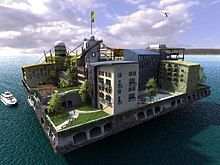Making an Island/Motivations
Urban Planning[edit | edit source]

In areas where space for living or activities are extremely limited, land reclamation and island building is often used to create usable space where there was once none. This is particularly useful in urban coastal cities, which are often built up right next to the coast.
Real Life Examples
- Building a major airport takes up a lot of land, often requiring it to be placed far away from the city center, and eliciting protests from residents disturbed by the noise and traffic it creates. Artificial islands avert such problems by placing the airport in the sea next to the bustling city center, as is the cast with Chubu Centrair International Airport in Nagoya.
- The creation of waterfront living-space is also desirable to many, and artificial land projects such as the Palm Jumeirah in Dubai serve both to create living space, and as a prestige project that increases the status of the city as a cutting edge space.
Infrastructure Support[edit | edit source]

While not the most exciting function for an artificial island, creating small islands to support infrastructure is perhaps one of the most useful applications of artificial islands.
Another infrastructure use for artificial islands includes creating a base for a lighthouse, as was done for the Cheboygan Crib Light in the Cheboygan River.
Environmental Support[edit | edit source]
Floating artificial islands are relatively straightforward to deploy, and have a number of ecologically beneficial uses. For example, artificial floating islands have been deployed as scaffolding for plant life in heavily polluted areas, giving support to struggling wildlife populations.[1]
Home Improvement[edit | edit source]
In rural areas it is common to build artificial ponds on a property, both for recreation and for practicality. Building an artificial island in the pond can create a unique space for secluded activities.
Seasteading[edit | edit source]


Seasteading is a movement that seeks to make the sea habitable. Many Seasteaders value the freedom of being outside the territorial waters of a state, and many simply want to be pioneers, homesteading a new frontier. While a full description of the seasteader movement is beyond the scope of this book, it should be noted that Seasteaders greatly value the idea of artificial islands for both philosophical and practical reasons. While seasteading can incorporate a number of concepts, typically either artificial platforms or simply living on ships, the idea of making an artificial island to permanently inhabit appeals to many.
Of course, inhabiting artificial islands outside the territorial claims of existing nation states must deal with the same problems as natural islands far from the mainland, primarily relating to either safety or logistics. Thus only the most dedicated seasteaders attempt this route. Seasteaders ideally have a maritime background as many skills are shared between the fields.
References[edit | edit source]
- ↑ Scott, Michael (3 September 2011). "Greening the Cuyahoga River: Man-made floating plant islands the latest scheme in recovery efforts" (in en). cleveland. https://www.cleveland.com/metro/2011/09/greening_the_cuyahoga_river_ma.html.